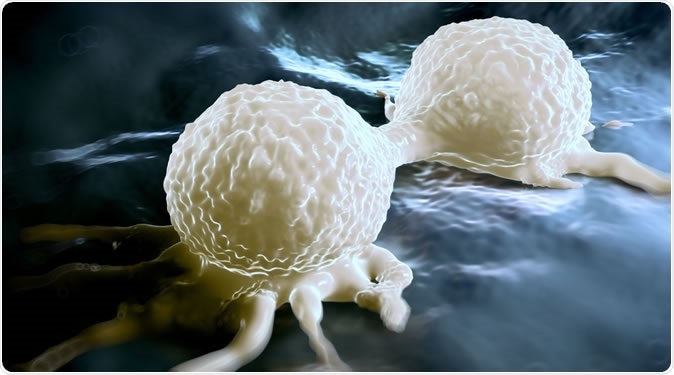New research presented at the Society for Endocrinology annual conference in Brighton appears to identify novel methods of therapy for an aggressive type of breast cancer as well as uncovering potential causative factors. The focus of the study is to show how common chemicals present in our surroundings are possibly putting women at risk of a type of breast cancer called triple negative breast cancer (TNBC).

Dividing breast cancer cell. Image Credit: Shutterstock
Breast cancer and nuclear receptors
Breast cancers that carry receptors for the female hormones estrogen and progesterone have been treated successfully using drugs that target these receptors. Another type of breast cancer called TNBC is found in younger women, is quite aggressive, and accounts for anything from one-tenth to one-fifth of all breast cancers. It is called ‘triple negative’ because its cells lack these important hormone receptors as well as a third target commonly exploited by hormone therapy and immunotherapy. As a result, it is curable only if diagnosed very early. The only avenues otherwise available are conventional surgery, chemotherapy and radiotherapy techniques – and successful cure is rare indeed.
The estrogen and progesterone receptors are only two of 48 receptors located within the cell nucleus (nuclear receptors, or NRs) that form a ‘superfamily’ called ligand-activated transcription factors. In other words, when a suitable molecular signal (ligand) binds to these receptors, they are activated to set off the process of decoding DNA to produce RNA, which in turn will eventually lead to the synthesis of a specific protein.
Genes form functional groups, and each NR activates only one gene set. On the other hand, the same gene sets may be encoded by different NRs. Thus groups of NRs may regulate the same gene sets in different combinations, creating significant overlap between the physiological functions they control. In this way, the NRs show functional redundancy, ensuring that the loss of function of one group of NRs (by mutations, for instance) will be compensated for by other groups, each of which encodes some of the same genes.
Many other NRs also show alterations during the development of a cancerous change in breast cells. These changes are therefore part of the tumor-causing process and as such, they could be the focus of new therapeutic strategies. The activity of these receptors has been shown to be altered by environmental chemical exposures, but the mechanism is still unknown. The greatest uncertainty is with respect to the origin of TNBC.
The study
The current study was aimed at uncovering the complete range of nuclear receptors from all types of breast cancer (using 168 samples), as well as from normal breast tissue. They compared the specific NRs that were expressed, with their mutations, to the patient outcomes, retrieving data from other studies that included much larger groups of breast cancer patients.
They were able to show that many NRs do indeed show altered levels of expression in breast cancer, and to uncover the association of NR expression to type of breast cancer. Thus they found that TNBC is associated with changes in the expression of 20/48 NRs, when compared with normal breast tissue cells. Among these, they found that 8/20 were associated with reduced survival in these cancer patients.
Using a computer program called Enrichr, they calculated the association between each gene set and the biological characteristics of the cell. This helped them to find which drugs or chemicals could potentially disrupt normal gene expression by activating or altering the expression of these NRs. They were able to examine the role of specific disinfectants, insecticides, industrial pollutants, prescription drugs, and fats in the diet, for instance, which could be potential drivers of the cancer-producing NR alteration. Each of these therefore represents a point for possible prevention or treatment of cancers mediated by dysregulation of these receptors.
Implications
Researcher Laura Matthews explains only if the various types of NRs are known can scientists discover the possible mechanisms by which they can be controlled, in the treatment of TNBC.
The next area they are investigating is how environmental exposure to these chemicals produces changes in NR-mediated cell behavior in the breast, as this could help reveal how cancer development occurs. At the same time, they are trying to determine the efficacy of using more than one drug to bind to multiple NRs simultaneously, in terms of whether this will prevent or treat TNBC more effectively. Matthews says, “Our goal is to reduce the number of people that develop breast cancer, and guide new therapies, so that more people can live beyond breast cancer.”
Journal reference:
Freya Leif, Pauline Pfänder, Syed Murtuza Baker, Ian Donaldson, Kathryn McGinnis, Fiona Leslie, James Thorne, Graham Cook, Christopher Twelves, Valerie Speirs & Laura Matthews, Nuclear receptor profiling predicts chemical disruptors as risk factors for developing breast cancer, Endocrine Abstracts (2019) 65 P130 | DOI: 10.1530/endoabs.65.P130, https://www.endocrine-abstracts.org/ea/0065/ea0065p130.htm